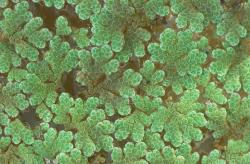Aquatic ferns, free-floating. Stems short, branching, glabrous or sometimes hairy, bearing pendent roots. Leaves monomorphic, bilobed; the upper lobe aerial, green, papillate, containing the cyanobacterium Anabaena in a large cavity on the lower surface; the lower lobe colourless and floating; both lobes glabrous. Veins absent. Sporocarps usually absent in NZ; when present, borne on the first leaf of a lateral branch, in the axil of the lower lobe and protected by the upper lobe; megasporocarps oblong-conical; microsporocarps ovoid to globular, usually larger than megasporocarps. Megaspores solitary in each megasporangium, bearing hair-like filaments at the base and floats (massulae) at the apex. Microspores 32–64 in each microsporangium, mixed with massulae that bear hooked processes (glochidia). Megaspores spheroidal, coarsely tuberculate, perforate; microspores spheroidal, plain.
Seven species widespread in tropical and temperate regions (Reid et al. 2006); four occur in North and South America, two in Africa and Asia, and two in Australia, one of which is also native to New Zealand and the other introduced. One naturalised and one native species in New Zealand.
| Category | Number |
|---|---|
| Indigenous (Non-endemic) | 1 |
| Exotic: Fully Naturalised | 1 |
| Total | 2 |
The base chromosome number in Azolla is x = 22 (Schneller 1990).
Plants of Azolla are free-floating and capable of covering large areas of slow-moving or still water. They are easily recognised as a red carpet of growth on the water surface. In New Zealand, fertile plants are rarely found, and reproduction is usually vegetative by fragmentation of the lower branches of the plants. Only five collections with sporocarps have been detected in New Zealand herbaria (AK 284894, CHR 168181, 214754, WELT P002240, P024125).
Azolla is of considerable economic importance in Asian countries where crops such as rice are grown in flooded fields. Azolla contains the cyanobacterium Anabaena which fixes nitrogen and is a source of fertiliser when the parent plant dies.
The phylogenetic relationships of all seven species of Azolla have been investigated by Reid et al. (2006) and Metzgar et al. (2007). Spores are illustrated by Tryon & Lugardon (1991).




